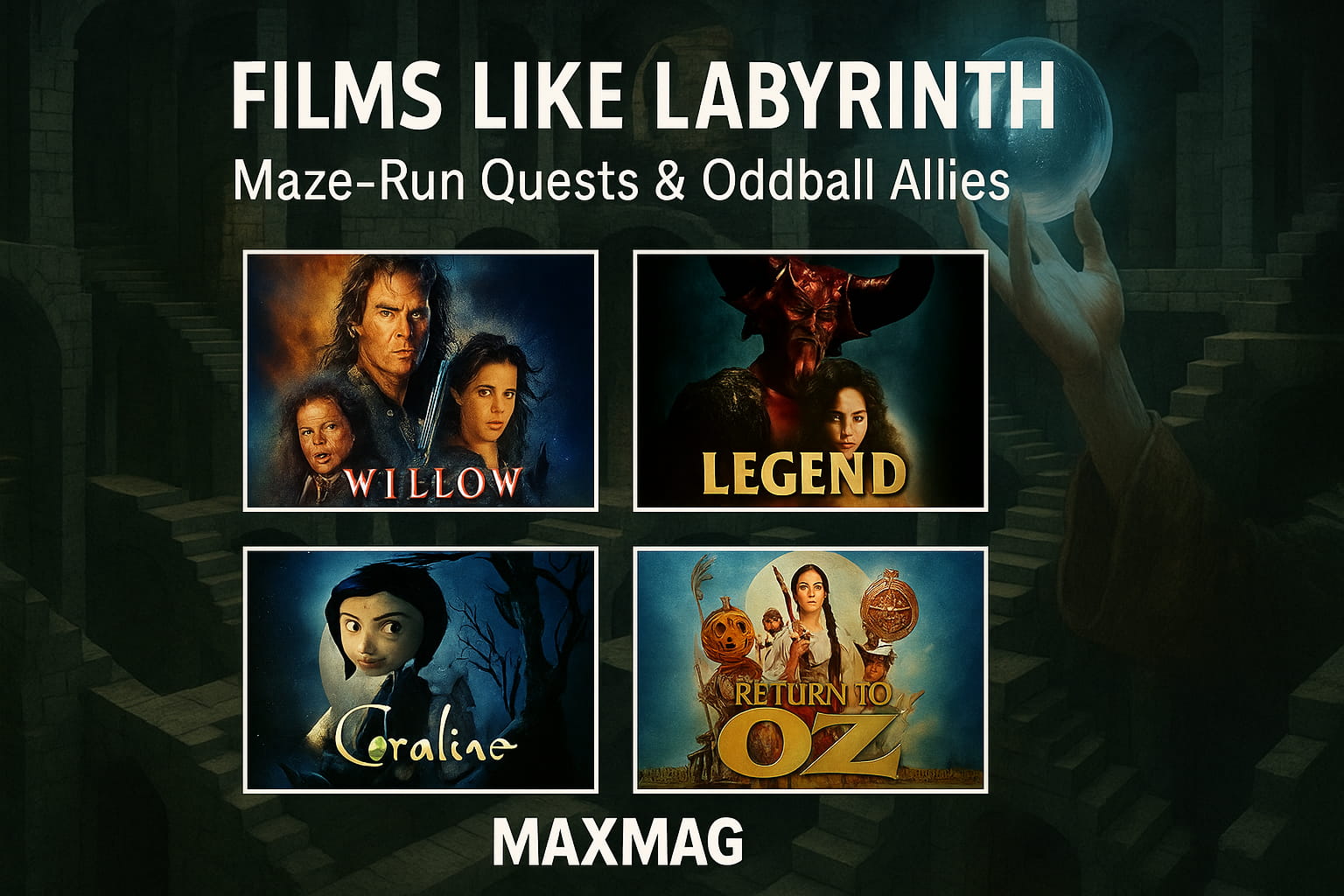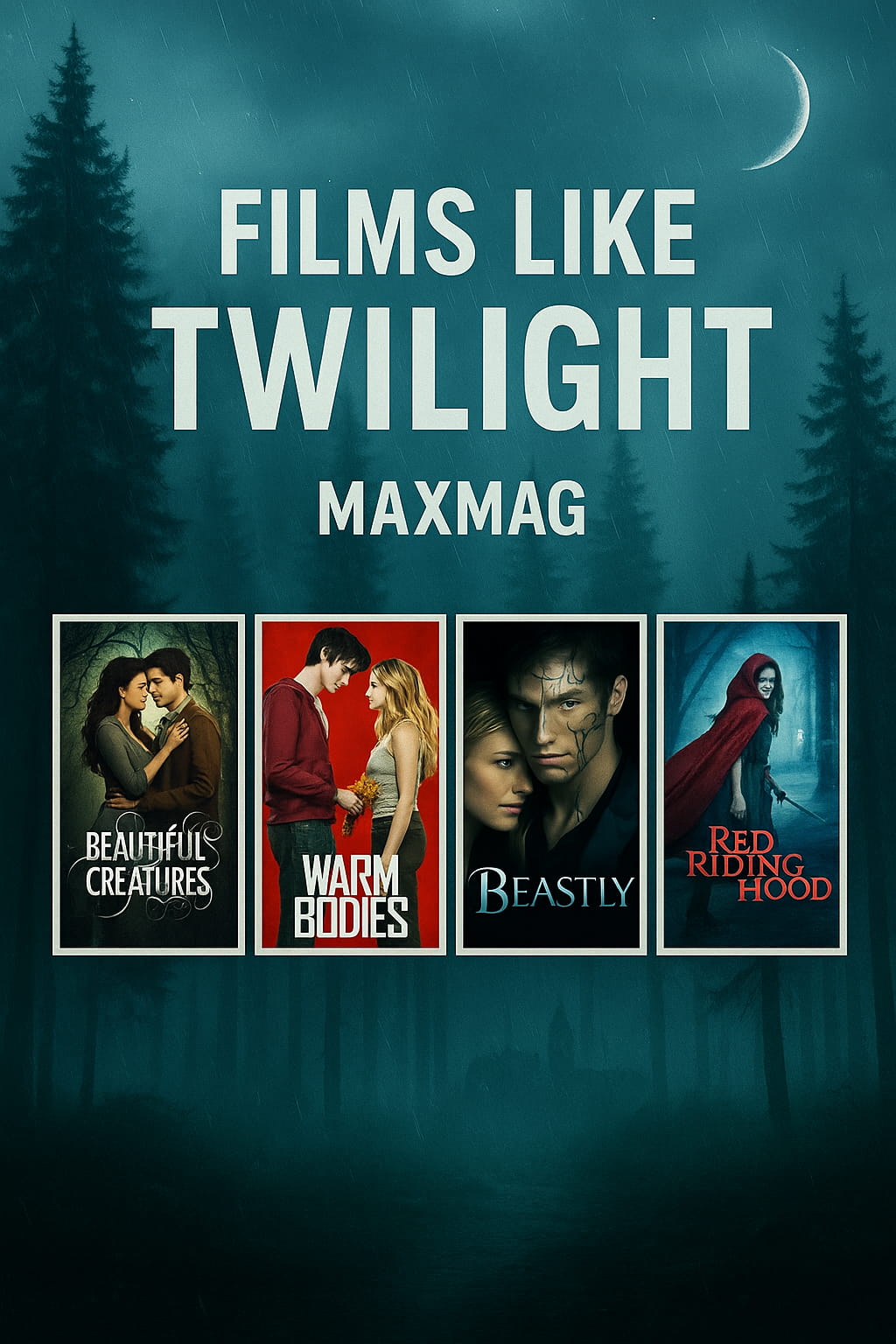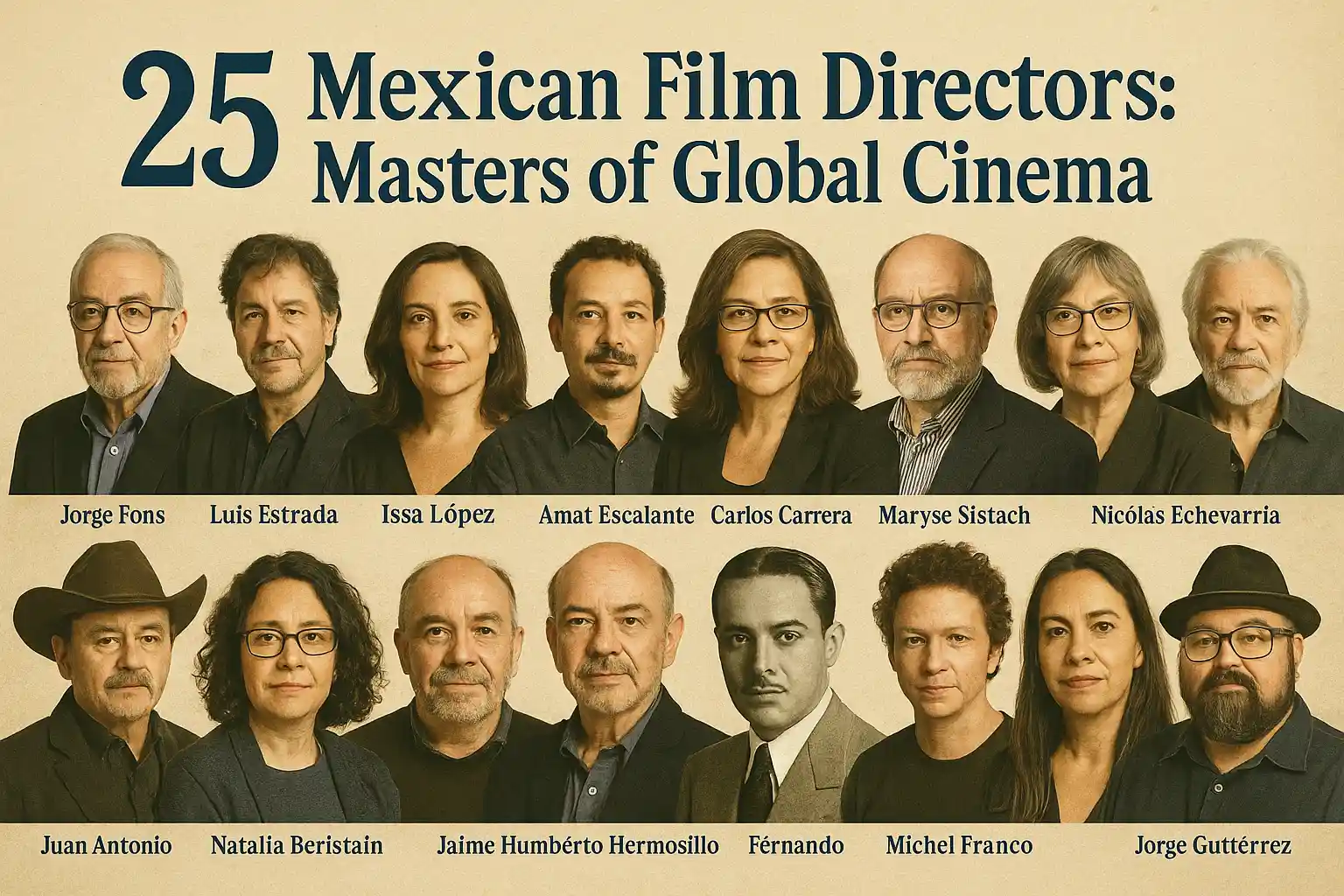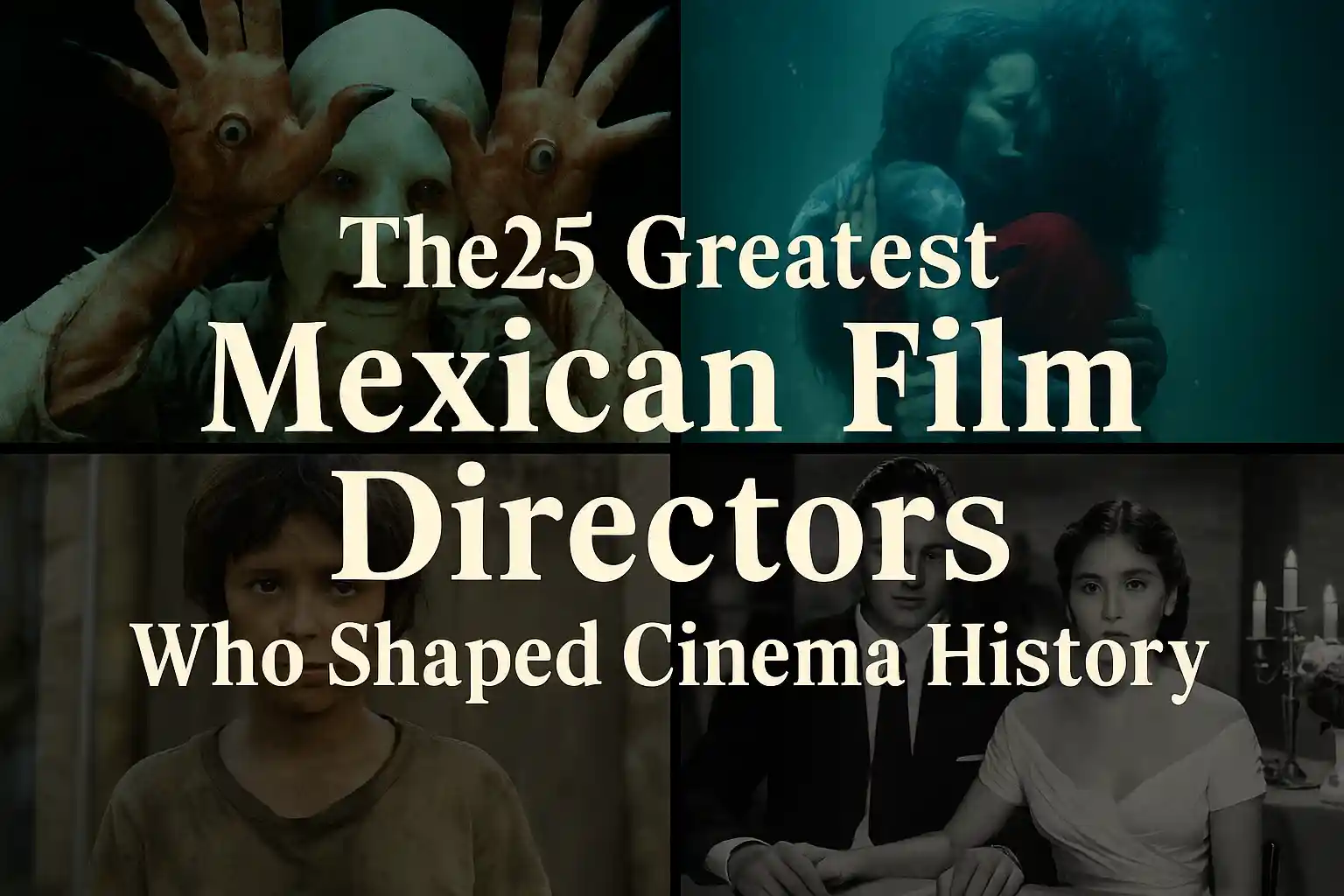
The history of Mexican cinema is one of artistic resilience, political boldness, and cultural pride. From the Golden Age’s sweeping black-and-white epics to surrealist masterpieces and modern Oscar winners, Mexican film directors have built a cinematic tradition that stands among the most influential in the world.
These directors have taken local stories — shaped by Mexico’s landscapes, traditions, and struggles — and elevated them to universal works of art. Whether exploring intimate dramas, sprawling political sagas, or fantastical worlds, Mexican film directors have redefined the power of storytelling, proving that films made in Mexico can resonate across borders, languages, and cultures.
25. Jorge Fons
-
Notable Films: Rojo Amanecer (1989), El Callejón de los Milagros (1995)
-
Awards: Silver Ariel, Berlin International Film Festival Special Mention
-
Active Years: 1966–2019
-
Style/Genre: Political drama, humanist realism
Jorge Fons was a fearless storyteller who dared to confront some of Mexico’s most sensitive historical and social wounds. Rojo Amanecer remains one of the boldest political films in Mexican cinema, portraying the 1968 Tlatelolco massacre entirely from within a single apartment, showing the tragedy through the eyes of one family. With El Callejón de los Milagros, adapted from Naguib Mahfouz’s novel, he demonstrated his mastery of ensemble storytelling, weaving together intersecting lives in a Mexico City neighborhood with warmth, humor, and tragedy. Fons’s work stood as proof that Mexican film directors could merge political courage with deeply human narratives, making him an enduring influence on socially engaged cinema.
24. Luis Estrada
-
Notable Films: La Ley de Herodes (1999), El Infierno (2010)
-
Awards: Ariel Awards, Guadalajara International Film Festival honors
-
Active Years: 1990–present
-
Style/Genre: Political satire, black comedy
Luis Estrada has carved out a unique place as Mexico’s sharpest satirist, using humor to reveal uncomfortable truths about corruption, crime, and politics. La Ley de Herodes dismantled the myth of political integrity with biting wit, earning both critical acclaim and government censorship attempts. El Infierno, released during the height of cartel violence, turned the grim realities of the drug trade into a darkly comic epic that resonated deeply with audiences. His work proves that Mexican film directors can provoke thought and laughter in equal measure, challenging audiences to confront the absurdity of corruption while never losing sight of human cost.
23. Issa López
-
Notable Films: Tigers Are Not Afraid (2017), Todo Mal (2018)
-
Awards: Best Director – Fantastic Fest, multiple international genre awards
-
Active Years: 2006–present
-
Style/Genre: Fantasy horror, magical realism
Issa López is redefining genre cinema in Mexico, blending fantasy and horror with biting social commentary. Her breakout, Tigers Are Not Afraid, follows a group of orphaned children navigating cartel violence, while ghostly figures and magical elements offer both comfort and danger. Praised by Guillermo del Toro and Stephen King, López crafts worlds where the supernatural is woven seamlessly into harsh realities, proving that Mexican film directors can use fantasy not as escape, but as a lens to confront the most pressing issues of the day. Her work bridges the gap between arthouse depth and genre thrills, expanding the scope of contemporary Mexican filmmaking.
22. Amat Escalante
-
Notable Films: Heli (2013), The Untamed (2016)
-
Awards: Best Director – Cannes Film Festival, multiple Ariel Awards
-
Active Years: 2005–present
-
Style/Genre: Social realism, surreal drama
Amat Escalante’s cinema is unflinching, often confronting audiences with stark depictions of violence, injustice, and moral decay. Heli shocked viewers with its portrayal of cartel brutality’s impact on ordinary families, while The Untamed introduced strange, otherworldly forces into a story about human desire, repression, and societal hypocrisy. Escalante’s visual precision and willingness to take narrative risks make him one of the most uncompromising Mexican film directors of his generation, constantly pushing the boundaries of what Mexican cinema can be both thematically and stylistically.
21. Patricia Riggen
-
Notable Films: Under the Same Moon (2007), The 33 (2015)
-
Awards: Sundance Audience Award, Imagen Awards
-
Active Years: 2005–present
-
Style/Genre: Family drama, inspirational true stories
Patricia Riggen has built a career on telling emotionally resonant stories that bridge cultures. Her debut, Under the Same Moon, explored the challenges of immigration through a tender mother-son narrative, becoming one of the highest-grossing Spanish-language films in U.S. history. With The 33, she dramatized the real-life rescue of Chilean miners, proving her ability to handle large-scale productions without losing sight of personal human stakes. Riggen’s work stands as a reminder that Mexican film directors can connect with global audiences without compromising cultural authenticity.
20. Carlos Carrera
-
Notable Films: El Crimen del Padre Amaro (2002), La Mujer de Benjamín (1991)
-
Awards: Academy Award nomination, Ariel Awards
-
Active Years: 1987–present
-
Style/Genre: Religious drama, social commentary
Carlos Carrera has never shied away from controversy. His internationally acclaimed El Crimen del Padre Amaro challenged the moral authority of the Catholic Church, sparking nationwide debate. Earlier, La Mujer de Benjamín revealed his gift for balancing intimate character studies with broader societal critique. Carrera’s bold storytelling ensures his place among Mexican film directors unafraid to confront power structures through art, making films that are as provocative as they are visually rich.
19. Maryse Sistach
-
Notable Films: Perfume de Violetas (2001), La Niña en la Piedra (2006)
-
Awards: Ariel Awards, Chicago International Film Festival recognition
-
Active Years: 1989–present
-
Style/Genre: Feminist drama, social realism
Maryse Sistach uses cinema as a platform to highlight the experiences of women and girls in Mexican society, often addressing issues of gender violence and inequality. Perfume de Violetas remains a landmark in socially conscious filmmaking, portraying the vulnerability and resilience of teenage girls in a patriarchal world. Through her compassionate yet unflinching storytelling, Sistach has earned her place among the Mexican film directors who merge artistry with activism, pushing for cultural conversations that extend far beyond the cinema screen.
18. Nicolás Echevarría
-
Notable Films: Cabeza de Vaca (1991), Eco de la Montaña (2014)
-
Awards: Ariel Awards, Sundance recognition
-
Active Years: 1973–present
-
Style/Genre: Ethnographic cinema, historical drama
Nicolás Echevarría is one of the foremost chroniclers of Mexico’s indigenous cultures and spiritual traditions. Cabeza de Vaca reimagines the journey of the Spanish explorer through a lens that honors indigenous perspectives, while Eco de la Montaña follows the life and art of Huichol shaman Santos de la Torre, bringing cultural heritage to the screen with authenticity and reverence. His work reminds audiences — and fellow Mexican film directors — that cinema can serve as a form of cultural preservation as much as it is an art form.
17. Juan Antonio de la Riva
-
Notable Films: Pueblo de Madera (1985), El Gavilán de la Sierra (2002)
-
Awards: Ariel Awards, National Film Archive honors
-
Active Years: 1980–present
-
Style/Genre: Rural drama, regional storytelling
Juan Antonio de la Riva has dedicated much of his career to capturing the rhythms and textures of rural life in Mexico, particularly his native Durango. His debut, Pueblo de Madera, is a love letter to the countryside — a place of beauty, hardship, and enduring traditions. Later works like El Gavilán de la Sierra continued this thematic commitment, blending personal nostalgia with a keen awareness of regional struggles. His cinematography often frames landscapes as living characters, while his narratives honor the resilience of rural communities. Among Mexican film directors, de la Riva is a guardian of cultural memory, ensuring that stories from the margins of urban centers are preserved for future generations.
16. Natalia Beristáin
-
Notable Films: She Doesn’t Want to Sleep Alone (2012), Los Adioses (2017)
-
Awards: Ariel Awards, San Sebastián International Film Festival accolades
-
Active Years: 2012–present
-
Style/Genre: Intimate drama, biographical storytelling
Natalia Beristáin is a filmmaker who thrives in the space between the personal and the political. Her debut, She Doesn’t Want to Sleep Alone, used the story of a fractured family to examine loneliness and emotional distance in modern Mexico. Los Adioses, a biopic of feminist writer Rosario Castellanos, combined lush period detail with a study of gender, ambition, and cultural change. Beristáin’s delicate pacing, strong visual compositions, and focus on women’s interior lives place her among the Mexican film directors reshaping the country’s cinematic voice for the 21st century.
15. Jaime Humberto Hermosillo
-
Notable Films: Doña Herlinda and Her Son (1985), Esmeralda Comes by Night (1997)
-
Awards: Ariel Awards, Guadalajara International Film Festival tributes
-
Active Years: 1972–2019
-
Style/Genre: LGBT cinema, social satire
Jaime Humberto Hermosillo was a pioneer in bringing LGBTQ+ narratives into the mainstream of Mexican cinema. His warm, comedic touch in Doña Herlinda and Her Son presented queer relationships with joy and normalcy, a radical move at the time. In Esmeralda Comes by Night, he again blended humor with complex social commentary, challenging conservative norms without alienating audiences. Hermosillo’s films celebrated individuality, pushed against censorship, and inspired a generation of Mexican film directors to explore more inclusive and diverse stories.
14. Fernando de Fuentes
-
Notable Films: Vámonos con Pancho Villa (1936), Allá en el Rancho Grande (1936)
-
Awards: Golden Ariel (posthumous recognition)
-
Active Years: 1930–1958
-
Style/Genre: Revolutionary epics, rural melodrama
Fernando de Fuentes was one of the architects of Mexico’s Golden Age of cinema, capturing both the heroism and tragedy of the nation’s revolutionary past. Vámonos con Pancho Villa remains a powerful anti-war statement, while Allá en el Rancho Grande essentially invented the rural musical melodrama. His films combined national pride with critical reflection, shaping a visual and thematic language that would echo through the work of countless Mexican film directors who followed.
13. Michel Franco
-
Notable Films: After Lucia (2012), New Order (2020)
-
Awards: Cannes Film Festival awards, Venice Silver Lion
-
Active Years: 2009–present
-
Style/Genre: Social drama, dystopian thriller
Michel Franco is known for his stripped-down, emotionally intense style. After Lucia examined the devastating consequences of bullying through a minimalist lens that left nowhere for the audience to hide. New Order shifted into dystopian territory, using shocking imagery to comment on class inequality and political unrest. Franco’s work refuses easy resolutions, forcing viewers to sit with discomfort — a quality that has made him one of the most divisive yet important Mexican film directors of his time.
12. Tatiana Huezo
-
Notable Films: Tempestad (2016), Prayers for the Stolen (2021)
-
Awards: Ariel Awards, Cannes Special Mention
-
Active Years: 2004–present
-
Style/Genre: Documentary, poetic realism
Tatiana Huezo’s filmmaking is a blend of lyrical imagery and investigative rigor. Tempestad wove the testimonies of two women into a haunting meditation on fear and injustice in modern Mexico. Prayers for the Stolen, her narrative debut, adapted Jennifer Clement’s novel into a visually stunning exploration of girlhood in a community dominated by drug cartels. Huezo has emerged as one of the Mexican film directors redefining what socially engaged cinema can be, proving that truth and beauty can coexist in the same frame.
11. Jorge Gutiérrez
-
Notable Films: The Book of Life (2014), Maya and the Three (2021)
-
Awards: Annie Awards, Emmy Awards
-
Active Years: 2000–present
-
Style/Genre: Animation, fantasy adventure
Jorge Gutiérrez’s work explodes with color, mythology, and unapologetic love for Mexican culture. The Book of Life brought Día de los Muertos traditions to a global audience, while Maya and the Three expanded his storytelling into an epic animated series steeped in Mesoamerican legend. His distinctive visual style, characterized by bold patterns and heartfelt narratives, has inspired a wave of animators and shown that Mexican film directors can lead in the world of animation as much as in live action.
10. Jaime Camil Sr.
-
Notable Films: Banana Mechanic (1970s), various comedy features
-
Awards: Industry recognition, contributions to commercial cinema
-
Active Years: 1970–2000
-
Style/Genre: Comedy, popular entertainment
Jaime Camil Sr. brought a showman’s instinct to filmmaking, crafting lighthearted comedies that resonated with everyday audiences. His ability to balance entertainment with cultural specificity made his work instantly relatable to Mexican viewers. By producing and directing projects that captured the humor and warmth of local life, he carved a niche in popular cinema and reminded the industry that Mexican film directors can achieve commercial success without abandoning their roots.
9. Alfonso Arau
-
Notable Films: Like Water for Chocolate (1992), A Walk in the Clouds (1995)
-
Awards: Ariel Awards, BAFTA nomination
-
Active Years: 1973–present
-
Style/Genre: Romantic drama, magical realism
Alfonso Arau occupies a unique place among Mexican film directors, bridging traditional storytelling with international cinematic appeal. His breakout film, Like Water for Chocolate, adapted from Laura Esquivel’s bestselling novel, became a global phenomenon, enchanting audiences with its blend of romance, family conflict, and the magical infusion of emotions into food. The film’s lush visuals and heartfelt narrative reintroduced Mexican cinema to the world stage in the early 1990s. Following this success, Arau ventured into Hollywood with A Walk in the Clouds, showing his adaptability while maintaining a signature warmth and sensitivity. His work consistently marries cultural authenticity with universal themes, making him an influential figure for directors seeking to navigate both national and international audiences.
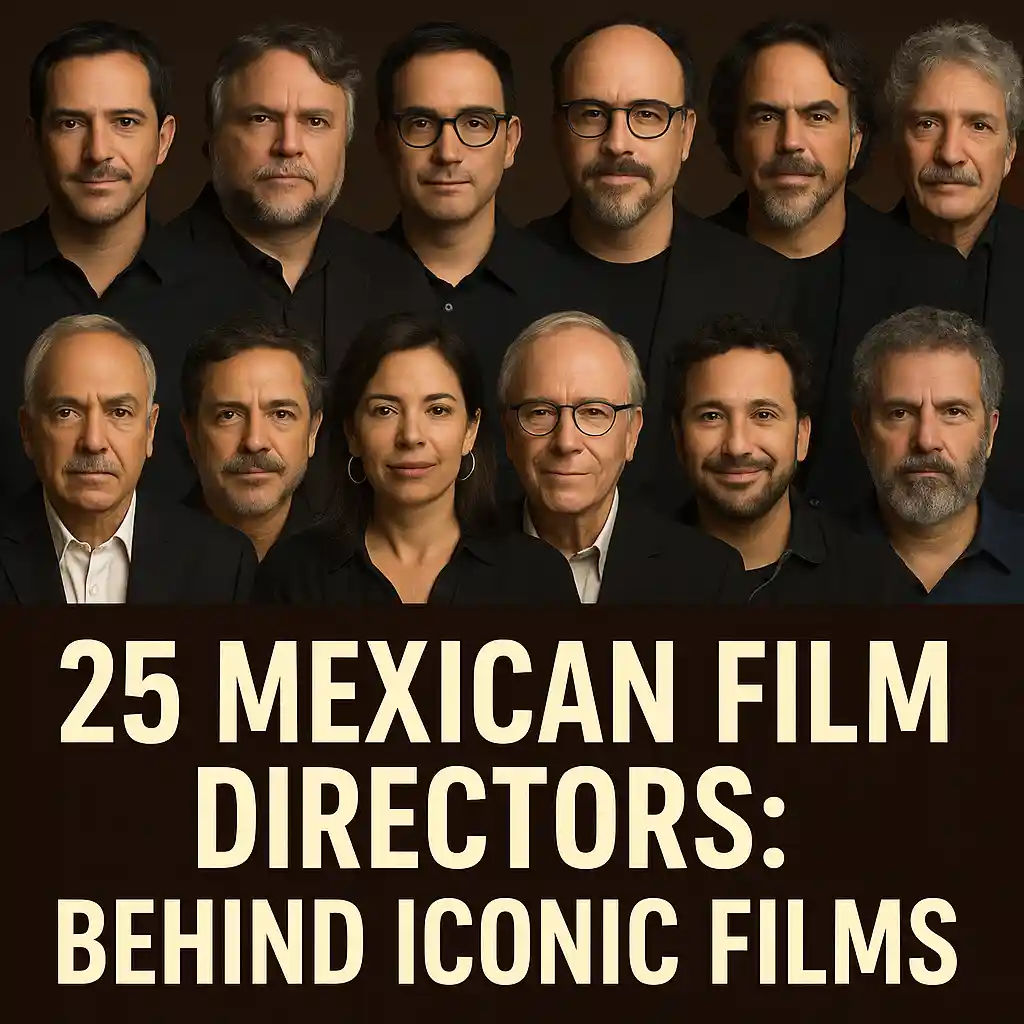
8. Carlos Reygadas
-
Notable Films: Silent Light (2007), Post Tenebras Lux (2012)
-
Awards: Cannes Jury Prize, Ariel Awards
-
Active Years: 2002–present
-
Style/Genre: Art cinema, spiritual drama
Carlos Reygadas is one of the most daring Mexican film directors working today, renowned for pushing the limits of cinematic language. In Silent Light, he transported viewers into the world of a Mennonite community in northern Mexico, capturing the interplay of faith, betrayal, and redemption through stunning natural light photography and meditative pacing. His later film, Post Tenebras Lux, abandoned conventional narrative structure entirely, embracing fragmented storytelling, surreal imagery, and raw emotional honesty. Reygadas’s films often ask viewers to slow down, observe, and engage with the unspoken — an approach that has earned him both fervent admirers and outspoken critics. His dedication to artistic risk ensures his place as a vital voice in Mexico’s cinematic landscape.
7. Alejandro González Iñárritu
-
Notable Films: Amores Perros (2000), Birdman (2014), The Revenant (2015)
-
Awards: Multiple Oscars, BAFTAs, Golden Globes
-
Active Years: 2000–present
-
Style/Genre: Multi-narrative drama, psychological exploration
Alejandro González Iñárritu burst onto the scene with Amores Perros, a gritty, multi-narrative masterpiece that redefined modern Mexican cinema. Its interwoven stories of love, loss, and violence became a touchstone for filmmakers worldwide. He carried his mastery of fragmented storytelling into Babel, then pivoted to bold formal experimentation in Birdman, a film designed to appear as a single, continuous shot — a technical and emotional triumph that won him the Oscar for Best Director. His visceral, immersive style reached new heights with The Revenant, a brutal survival tale that tested both actors and audience. Iñárritu’s ability to blend emotional intensity with formal innovation sets him apart among Mexican film directors, ensuring his work resonates on both an artistic and commercial level.
6. Guillermo del Toro
-
Notable Films: Pan’s Labyrinth (2006), The Shape of Water (2017)
-
Awards: Oscars, Golden Lion, BAFTAs
-
Active Years: 1993–present
-
Style/Genre: Fantasy, gothic horror
Guillermo del Toro is one of the most beloved Mexican film directors, celebrated for blending the fantastical with deeply human stories. His magnum opus, Pan’s Labyrinth, is a haunting fairy tale set against the backdrop of post–Civil War Spain, intertwining political brutality with the innocence of a child’s imagination. The Shape of Water, a tender romance between a mute woman and a mysterious aquatic creature, won four Academy Awards, including Best Picture and Best Director. Del Toro’s films are instantly recognizable for their meticulous world-building, rich color palettes, and empathy for outsiders and “monsters.” Beyond his directorial work, he actively champions genre cinema and mentors emerging filmmakers, extending his influence far beyond his own projects.
5. Alfonso Cuarón
-
Notable Films: Y Tu Mamá También (2001), Gravity (2013), Roma (2018)
-
Awards: Multiple Oscars, Golden Globes, BAFTAs
-
Active Years: 1991–present
-
Style/Genre: Drama, sci-fi, intimate realism
Alfonso Cuarón’s career exemplifies range and mastery. His early success with Y Tu Mamá También — a provocative coming-of-age road trip that doubled as a commentary on Mexico’s social and political climate — demonstrated his ability to blend personal intimacy with broader cultural insights. Transitioning seamlessly into Hollywood, he crafted the visually breathtaking Gravity, a survival story in space that revolutionized cinematic technology. With Roma, Cuarón returned to his roots, delivering a deeply personal, black-and-white portrait of his childhood home life in 1970s Mexico City. This film earned him three Oscars, including Best Director. His ability to move between deeply personal storytelling and large-scale spectacle makes him one of the most versatile and influential Mexican film directors alive.
4. Luis Buñuel (Mexican Period)
-
Notable Films: Los Olvidados (1950), The Exterminating Angel (1962)
-
Awards: Cannes Best Director, Academy Honorary Award
-
Active Years in Mexico: 1946–1977
-
Style/Genre: Surrealism, social critique
Luis Buñuel, though born in Spain, created some of his most celebrated works during his decades in Mexico, leaving an indelible mark on the nation’s cinematic heritage. Los Olvidados combined unflinching social realism with surrealist touches, telling a harrowing story of marginalized youth in Mexico City. The Exterminating Angel offered biting social satire, trapping a group of aristocrats in a dinner party they inexplicably cannot leave. His Mexican period showcased his ability to merge philosophical subtext, political critique, and experimental narrative structures. For many Mexican film directors, Buñuel’s work is both a masterclass in boundary-breaking cinema and a reminder that national film industries can be enriched by international voices.
3. Emilio “El Indio” Fernández
-
Notable Films: María Candelaria (1943), La Perla (1947)
-
Awards: Cannes Grand Prix, Ariel Awards
-
Active Years: 1941–1970s
-
Style/Genre: Melodrama, national identity
Emilio Fernández was the heart of Mexico’s Golden Age, crafting emotionally rich, visually poetic films that celebrated the country’s landscapes, traditions, and spirit. María Candelaria, which won the Cannes Grand Prix, told a tragic love story set in the canals of Xochimilco, combining romance with a critique of prejudice and injustice. La Perla, adapted from John Steinbeck’s novella, blended moral allegory with sweeping cinematography. Working closely with cinematographer Gabriel Figueroa, Fernández developed a visual language that became synonymous with Mexican national cinema. His work continues to influence Mexican film directors, providing a template for how national pride and universal storytelling can coexist.
2. Gabriel Figueroa (as Director & Cinematographer)
-
Notable Films: La Perla, Macario
-
Awards: Academy Award nomination, Ariel Awards
-
Active Years: 1930s–1980s
-
Style/Genre: Visual auteur, poetic realism
Gabriel Figueroa is revered primarily as a cinematographer, but his directorial contributions are equally noteworthy for their painterly precision. Drawing inspiration from Mexican muralists and European masters, Figueroa infused his films with a unique visual poetry — vast skies, dramatic light, and meticulous composition. His work in Macario captured the mysticism of Mexican folklore, while La Perla remains a visual and thematic masterpiece. Among Mexican film directors, Figueroa stands as a testament to the power of imagery in storytelling, showing that light and shadow can be as expressive as words.
1. Alejandro Jodorowsky
-
Notable Films: El Topo (1970), The Holy Mountain (1973)
-
Awards: Cult status, international retrospectives
-
Active Years: 1960s–present
-
Style/Genre: Surrealism, spiritual allegory
Alejandro Jodorowsky is perhaps the most unconventional of all Mexican film directors, a visionary whose work defies categorization. El Topo became the original “midnight movie,” fusing western motifs with mystical and philosophical allegories in a hallucinatory narrative. The Holy Mountain pushed cinematic surrealism to its peak, presenting a series of symbolic, visually stunning tableaux that explored spirituality, greed, and human transformation. Jodorowsky’s films challenge viewers to abandon conventional expectations and embrace cinema as a transformative, almost ritualistic experience. His influence extends far beyond Mexico, touching filmmakers, artists, and musicians across the globe.
Legacy and Global Impact of Mexican Film Directors
The story of Mexican film directors is one of resilience, innovation, and deep cultural pride. From the pioneers of the Golden Age who crafted sweeping epics celebrating national identity, to modern auteurs pushing cinematic boundaries on the world stage, these visionaries have given Mexico a voice in the global film conversation that cannot be ignored. Their work spans every genre — from magical realism and political satire to hard-hitting social dramas and fantastical animation — proving that Mexican cinema is as diverse as the nation itself.
Institutions like the Cineteca Nacional de México and theAcademia Mexicana de Artes y Ciencias Cinematográficas play a vital role in preserving and promoting this legacy, ensuring future generations can discover the artistry and bravery behind these films. Whether telling intimate human stories or crafting bold social critiques, Mexican film directors continue to inspire audiences worldwide, challenging us to see the world through new perspectives while holding a mirror to their own society. Their collective influence has not only shaped Mexico’s cultural identity but also enriched the very language of cinema itself.

